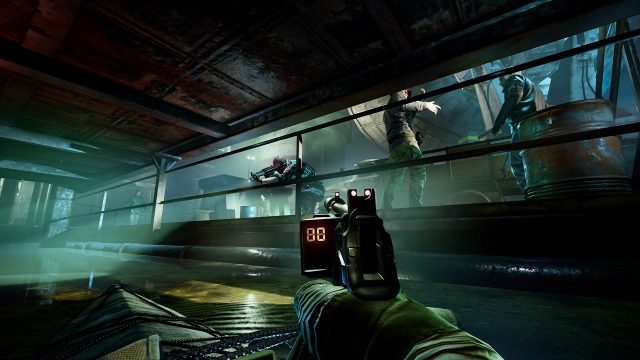The premise of Phantom: Covert Ops almost sounds ridiculous at first blush: you’re a special forces dude in a tactical kayak who is slinking around the waterways of an old Russian base. But don’t let the silinees of a tactical kayak fool you, this is actually a fundamentally compelling and immersive approach to a VR stealth game, but with one unfortunate conceit.
Phantom: Covert Ops is a game that’s played entirely from inside a kayak. And while that might sound strange at first, let me tell you, the whole thing feels incredibly immersive. Covert Ops is a seated game, and something about being seated and feeling like you’re gliding just over the top of the water feels (perhaps ironically) very grounding.
Your tactical kayak has mounted on it several tools and weapons, and as you see it constantly stretched out in front of you, it almost starts to feel like an extension of yourself right there in VR, bringing a sense of embodiment which is a key element of immersion.
On the left side you’ve got your kayak paddle which works pretty much exactly like you’d expect: alternating paddling on the left and right propels you forward, while paddling more on one side or the other turns you in the opposite direction. If you’ve ever kayaked or canoed before, it’s entirely second nature.
When you aren’t paddling, you’ll find an ammo pouch and night vision goggles sitting in front of you, a sniper rifle mounted on the right side, as well as a pistol on your chest and an SMG on your back. This makes up your trusty tool kit with which you’ll use to do all the usual stealth game stuff like sneaking through dark areas to avoid enemies, shooting out lights, causing distractions, and sabotaging the bad guys from the shadows.
Building the whole game around the kayak as a means of embodying the player, acting as their inventory, and moving them around the virtual world is an absolutely cool concept not seen anywhere else in VR. But there’s one conceit to this design which may limit the game’s audience, and that’s comfort.
Because you’re in a kayak, Phantom: Covert Ops is inherently built for smooth locomotion. That’s not an issue, at least for me; gliding along the water in mostly straight lines feels just fine. Unfortunately the kayak-based locomotion also brings with it smooth turning.
Smooth turning is when the player’s virtual perspective is continuously rotated. Most VR games employ ‘snap turning’ instead, which rotates the player’s view in large increments to avoid the perception of continuous turning. In the games that even support smooth turning, the option is never enabled by default because it makes lots of people nauseous, including me.
Unfortunately, smooth turning foundational to Covert Ops, and the developers don’t have plans for a snap turning equivalent. To be fair, a snap turning solution that makes sense in the kayak context doesn’t seem obvious to me; the necessity of smooth turning is a conceit it seems the game and its players will need to live with.
You could make the case that—if a VR game had to include smooth turning—Covert Ops is a best-case scenario. Because players don’t have control over their rotation with a joystick, they won’t be rotating nearly as much as they would in a standard FPS. Instead, rotation happens only when you paddle enough on one side of your kayak to turn, and levels have been clearly designed to minimize excessive rotation. Even so, it might get to you.

In my preview of Covert Ops, played on a Rift S, I was able to play for about an hour at a time before feeling like I was reaching that dreaded threshold of pushing the comfort limit too far and paying for it with an hour of post-headset nausea. For the most part, gliding along the water in relatively straight lines felt just fine, and a little bit of turning here and there felt ok too. But it was the ‘sharp turn’ mechanic where I could really feel my brain saying “nah man, this isn’t cool.”
The sharp turn mechanic allows you to turn extra sharp by holding a button on your controller and paddling at the same time, causing your kayak to turn much sharper than normal. You don’t need to do this constantly, but every few minutes you might find yourself at a bend in the waterway that requires a sharp turn, or a rapidly approaching guard boat that you need to quickly divert from.
It’s clear that Phantom: Covert Ops‘s developer, nDreams, is aware that sharp turns are a comfort issue. The game does its best to help maintain comfort by bringing heavy peripheral blinders into view during sharper turns. Even so, it wasn’t enough to avoid that slow buildup of discomfort that eventually made me take off the headset before I otherwise would have.
But I’m with nDreams here—I can see why they have continued to pursue this design. The kayak concept is so cool and the execution seems really quite good. Players who know they can handle smooth turning with no problem should be excited for Phantom: Covert Ops. Those who struggle with smooth turning should be careful not to push themselves too far with the game. And for those who are very sensitive to smooth turning, this game simply may not be for you.
To nDreams’ credit… the primary issue here for someone like me (who is in the middle camp of ‘struggles with smooth turning’), is that I wanted to play the game in long stretches. If it was a 15 minute session here or there, the extent of the smooth turning might not be much to tolerate. But so far Phantom: Covert Ops has been a really unique and interesting VR game that I want to dive into and stay immersed in for meaningful stretches of time.
I’m still looking forward to Phantom: Covert Ops because of all the stuff it’s doing right so far, and I hope nDreams might able to find some solutions to improving smooth turning comfort ahead of the game’s June 25th release date on Rift and Quest.







